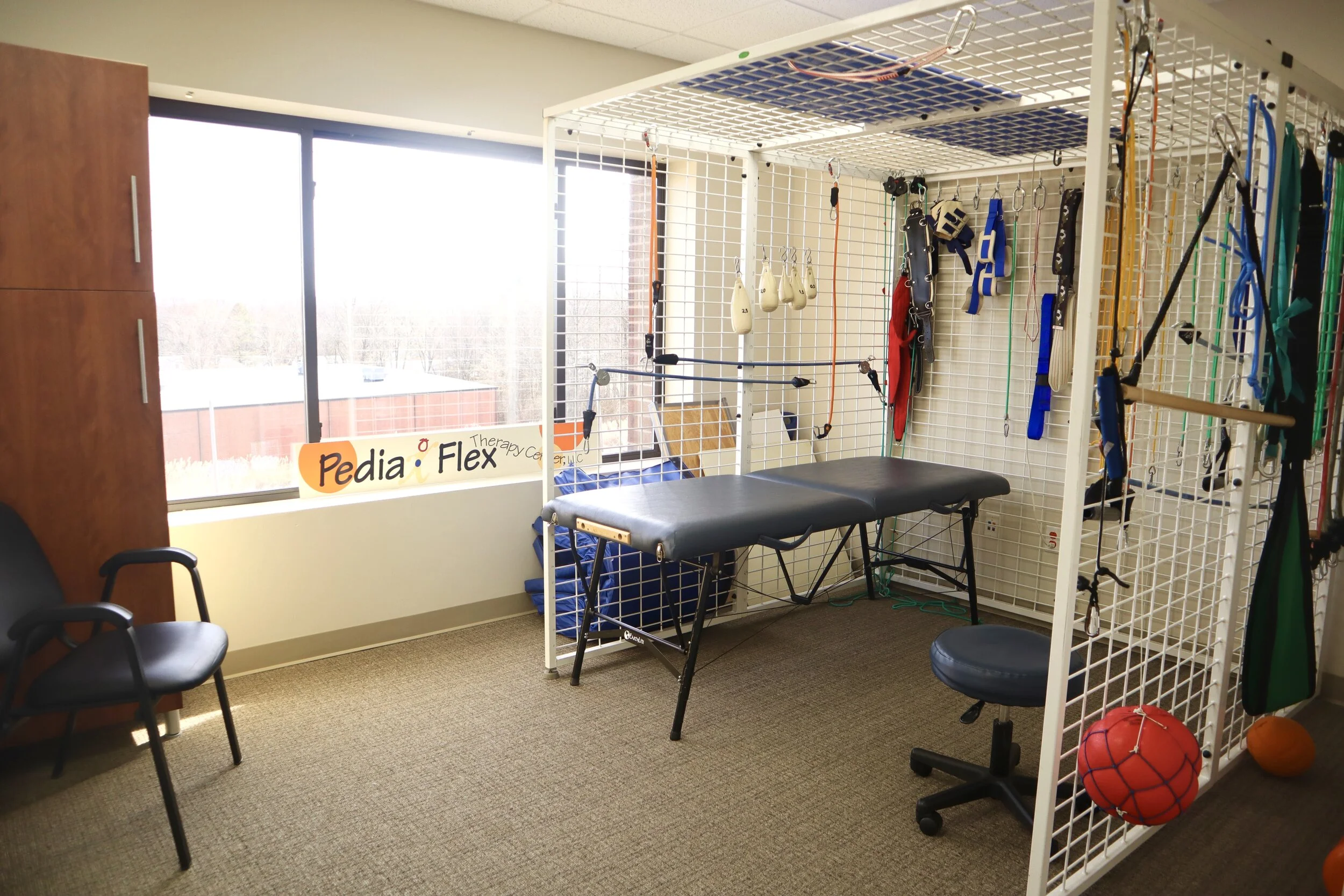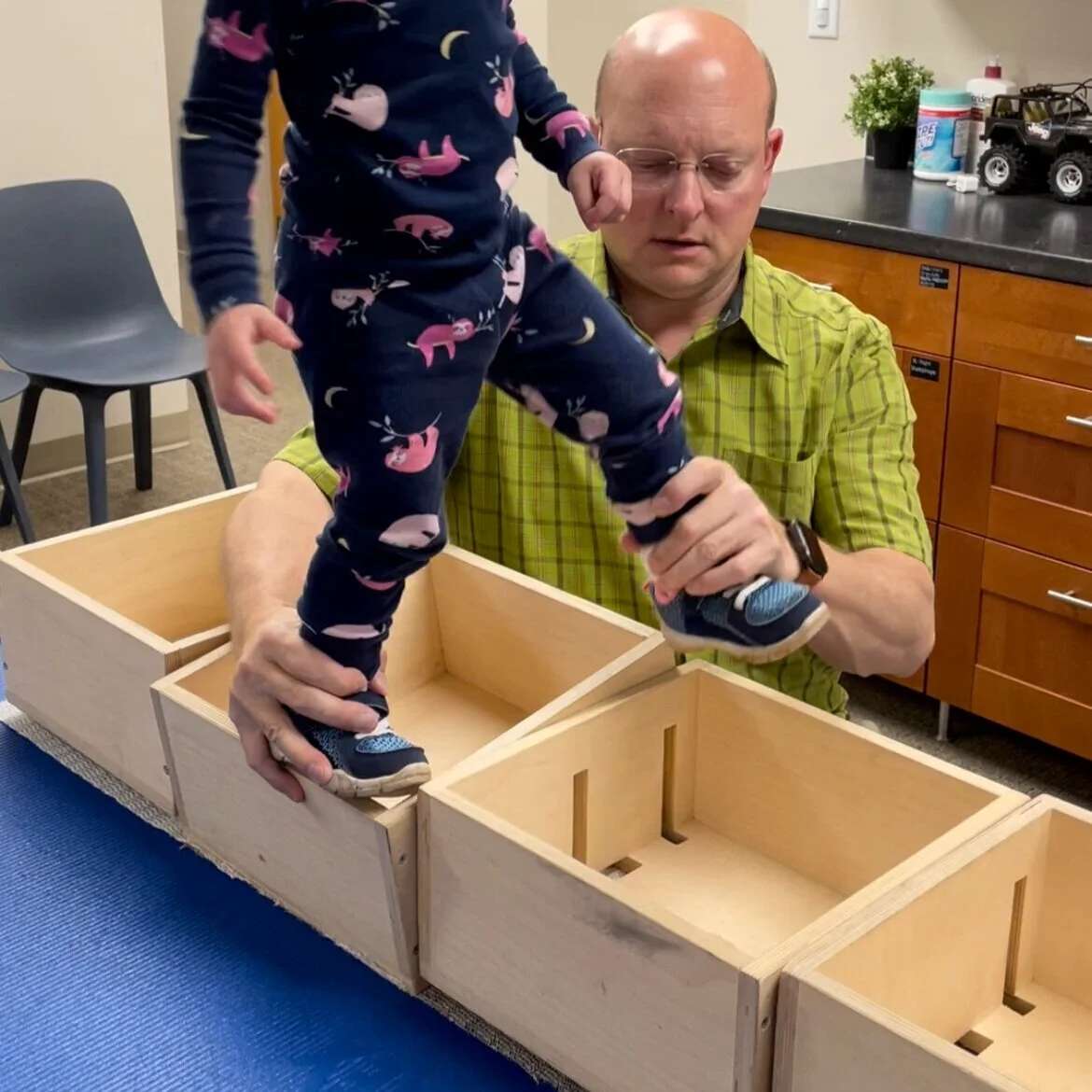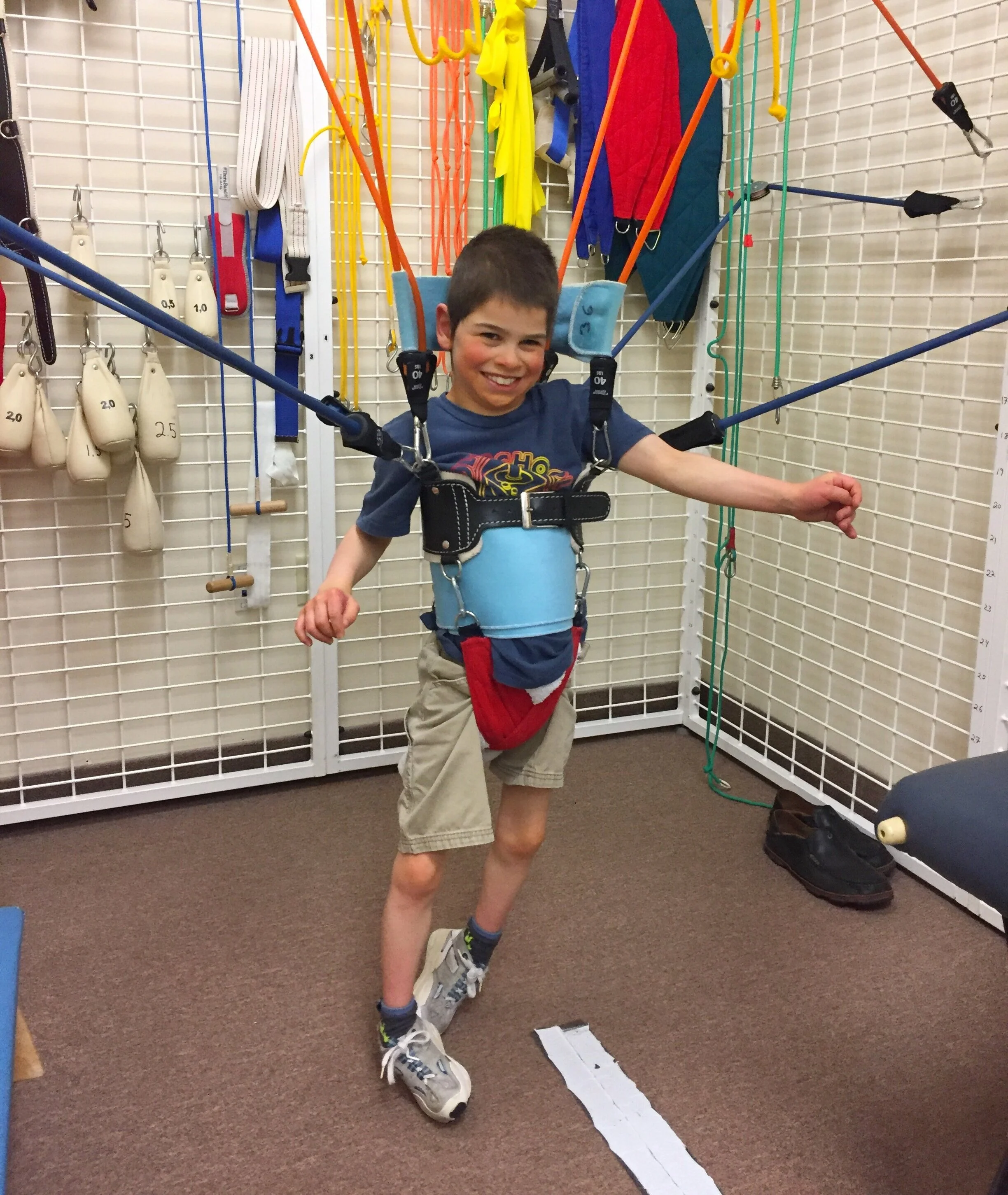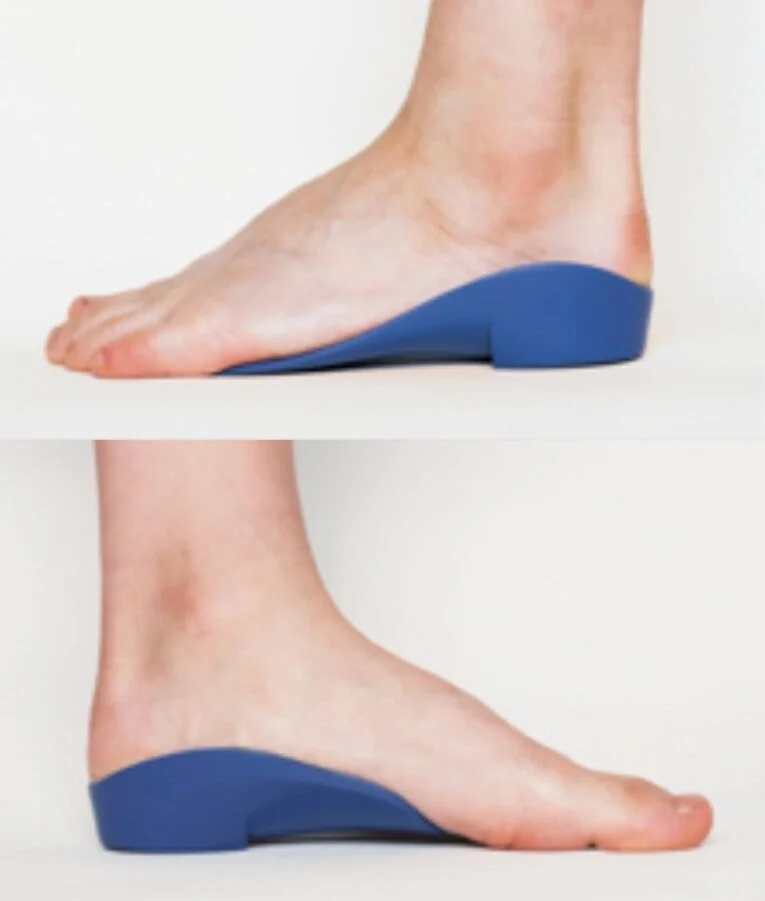
Weekly Therapy
We specialize in treating and caring for patients who are infants, toddlers, children, teenagers and young adults. We treat conditions related to genetic, neurological and orthopedic disorders. Play, family involvement, and one-on-one care are a primary characteristic of weekly pediatric PT at PediaFlex. Fun and motivating activities are incorporated into functional activities to make each visit enjoyable. Our focus is to help the kids become more independent and enjoy a greater quality of life. We use a variety of technology and therapeutic approaches that help kids to gain strength, improve gross motor skills, increase their range of motion, and develop better balance. We are involved with collaboration of care regarding bracing, prosthetics, walkers and wheelchairs and assistive technology. Our focus is to help the kids become more independent and enjoy a greater quality of life.
We realize there are times when therapy needs to be expanded beyond the outpatient clinic. Therefore, we offer a variety of out-of-office professional services. This can include consultation, evaluation, and direct services for school based/educationally IEP mandated PT services, We are able to schedule out-of-state travel or tele-medicine consultations. We will consider on a case-by-case basis meeting the needs for home bound therapy service that are within the greater Hartford region and Tolland County.
There are a variety of specific therapy technologies and approaches that we use. We are always on the hunt for progress, improvements and new approaches. We have found the therapies below on this page to be most helpful in caring for our kids with neurodevelopmental conditions.
Would you like to get started with Weekly Therapy?
Services and Products we offer:
DMI - Dynamic Movement Intervention
A large portion of our therapy involves Dynamic Movement Intervention (DMI) for at-risk infants and young children experiencing delayed motor development. The goal of DMI is to gain body control by exposing the child to gravity and to stimulate the postural control centers of the brain. This is done through a series of well-developed and practiced exercises - head control exercises, transitions through rolling, learning to sit and stand, early walking skills, and negotiation of steps and common barriers. Our therapists provide just-right support to provoke postural responses while the child works to gain control and balance.
Spider Cage - The Universal Exercise Unit
The use of this therapy system involves a cage and a variety of bungee straps that help to reduce gravity. In this unique suspended position, the kids practice different activities that help improve strength, movement, and flexibility. We notice tremendous gains in balance, coordination and function. If the kids are not able to stand on their own, the cage can be helpful to provide a gravity safe place to complete their exercise. With the pulleys and straps, our PT’s can isolate a muscle group, target it for movement, and counteract spastic muscle tone patterns. The goal is to ultimately improve functional independence with transfers, walking, and gross motor skills. Here are a few research articles explaining its helpfulness.
Whole Body Vibration Platform
“The Rumblex Plus delivers efficient, gentle Whole Body and Multidirectional vibrations, waking muscles throughout the body and triggering myofascial release. This, in turn, enhances your body’s built-in ability to regenerate cells and repair itself.” - lifeprofitness.com
Benefits:
improves flexibility
builds strength
improves balance.
Hand and Foot Wake Up Exercises - Hand/Foot Program
The ultimate goal behind these Hand and Foot Wake Up Exercises is to help children integrate their hands and feet for daily self-help skills. This includes things like pulling themselves up to stand, carrying objects in their hands, using their hands to stabilize or protect themselves, walking on different textures, taking care of foot hygiene, and putting on socks and shoes. Essentially, we want our kiddos to be able to use their hands and feet purposefully and do things more independently.
Play Dough Activity
Taping Highways
Hand Tracing
Sharp vs Dull Discrimination
Finger Weaving
Sponge Squeeze
Paper Crumbling
Texture Matching: Stereognosis
Hand/Finger Laterality with Waterable Marker
Finger Opposition
10 Step by Step Videos
LiteGait - Body Weight Support Treadmill Gait Training
The LiteGait® is a supportive lift and harness system to help kids learn to walk while they are on the treadmill. When the kids are supported, gait training can be practiced for longer durations and specific gait deviations can be worked on and addressed. The LiteGait® and treadmill combination allows repetition and intensity of training in the task-specific practice of walking. We have found excellent outcomes with the use of the LiteGait® for improving endurance, muscle strength, and weight-bearing when it is followed by walking practice over ground. Mobility Research developed the LiteGait® and holds 25 years of innovation, products, and Education Rehab Services, and we love ours!!
CO-OP - Cognitive Orientation to Daily Occupational Performance
In our efforts to help children with clumsiness, or motor dyspraxia, we have found excellent results using the CO-OP Approach™. The child with motor dyspraxia has difficulty learning new tasks - this is called motor planning. This might include activities such as riding a bicycle, swinging on a swing, jumping rope or other gross motor skills. The CO-OP Approach™ incorporates learning and cognitive behavioral theories to help develop a problem-solving strategy to achieve a particular goal. Rather than providing only direct instruction, our therapists help the kids discover how to perform an activity through “global cognitive strategy.” This may include drawing a picture, making a list, making a menu or flow chart, analyzing a video, or writing a story. Sequencing skills are not natural for some kids. Helping them break down a task verbally or visually, and getting them to “talk” about what they are seeing and experiencing, can trigger easier flow of these problem-solving skills.
NMES/FES - Therapeutic Electrical Stimulation
Neuromuscular Electrical Stimulation (NMES) uses a safe stimulation device that sends electrical impulses to nerves. This input causes muscles to contract. The electrical stimulation can increase strength, motor control and range of motion. It is often used to “re-train” or “re-educate” a muscle to function and to build strength after a surgery or period of disuse. Functional Electrical Stimulation (FES) is the use of the stimulation during a task. For example, “foot drop” is a common problem for a child with a neurological injury. We apply FES to the nerves and muscles that lift the foot. Then, while walking, the switch is pushed precisely when the muscle is needed to lift the foot. The outcomes of both NMES and FES are great - increased strength in muscles, improved range of motion at the joint, and efficiency of movement.
TAAP - Treadmill for students with Apraxia and Autism Protocol
Many of our kids struggle with combinations of difficulty. These can include gross motor mobility difficulties, fine motor challenges, visual motor challenges, and core postural control. The TAAP sequences of walking on to and riding off the treadmill is a great way to combine a therapeutic challenge that integrates these difficulties. The kids start out behind the treadmill, are given a specific task, walk onto the moving platform, touch, take or do something with their hands, and ride back off to the beginning. This has been a wonderful way to not only build strength, but incorporate visual-spatial orientation, postural responses and sequencing. TAAP has powerful potential to provide an avenue for neurological development. We have found it very helpful here at PediaFlex. This pdf article explains more about the use of TAAP here at PediaFlex. Great Job Deb!!! Facebook Link
Custom Foot Orthotics - Sole Supports
Sole Supports are amazing!! Simply put, they are like trunk leaf springs in your shoes, supporting your arch upwards, and allowing your body weight to be absorbed comfortably. They do not allow the foot arch to bottom out and makes for very comfortable and efficient walking and running. Technically, we take a mold of the feet and then have orthotics made to provide corrected arch postural support. When the bottom of the foot is mapped, it is capturing the foot in its maximum available supinated position. Through a unique algorithm and manufacturing process, the orthotics are made to a predetermined thickness so as to support each individual’s unique body weight. Sole Supports actually change how a foot functions on the ground. By capturing the highest available arch posture and using the you or your child’s specific weight, the shoe inserts act as a spring in the shoe, allowing some collapse and absorption of the body while walking. This spring effect assists the kid’s development of walking and gross motor skills.
Foot Orthotics for In-toeing - littleSTEPS Gait Plates
littleSTEPS® Gait Plates are made to help correct in-toeing of early walkers. Left untreated, toe-in gait may impair proper development of the lower limb and lead to difficulties with structural, strength, balance, and coordination deficits. As best described by Nolaro24, the manufacturer of these foot orthotics, “littleSTEPS® Gait Plates work by utilizing a semi-rigid shell that effectively alters the break of the ball of the foot during propulsion to encourage realignment of the hip in gait.” We like how the littleSTEPS® Gait Plates helps the child’s limb from turning in and supports the arch of the foot. These can be fit right in the office without casting.
DYNAMIC ORTHOTIC GARMENTS AND TAPING
These are fabric orthotic undergarments and cloth tape. These applications can be combined with flexible and/or rigid materials and stays that help postural alignment, sensorimotor processing, stability, movement, and muscle function. There are a variety of product lines including Kinesio Tape®, McConnell Taping, Dynamic Movement Orthoses, TheraSuit®, TheraTogs™, and Spio™. These products can be worn during the day or during a therapy session. Some are worn over clothes, and some are designed to be worn against the skin for prolonged periods of time. These dynamic applications are used to facilitate the development of gross and fine motor skills like sitting, standing, and walking.
















